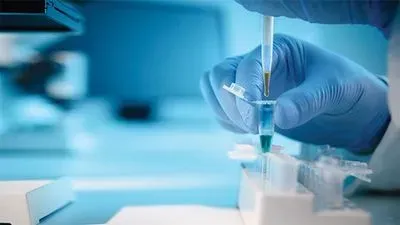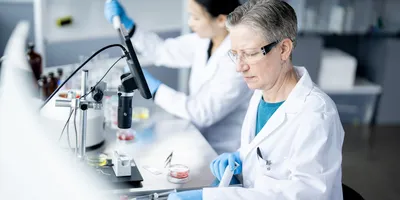Understanding pipette contamination types is key
Preventing contamination in pipetting is paramount to achieving reliable results. It requires identification of the potential contamination mechanisms so that they can all be addressed.
Aerosols, suspensions of solid or liquid particles in a gas, are formed in many laboratory activities such as pipetting with air-displacement pipettes, and aerosols are the major contamination source in pipetting. They may transfer into the pipette body when unfiltered pipette tips are used and consequently contaminate subsequent samples. A slow and careful pipetting rhythm helps minimize aerosol formation.
This article addresses the three contamination types that originate from pipetting: pipette-to-sample contamination, sample-to-pipette contamination, and sample- to-sample contamination.
Pipette-to-sample contamination
This type of contamination occurs when a contaminated pipette or pipette tip contaminates the sample.
Pipette tips are available in multiple purity grades from most manufacturers. Purity grades can be divided into three categories:
- no purity certification
- certified free of contaminants like DNase, RNase, and endotoxins
- sterilized to be free of microbial life
Contaminants such as DNase, RNase, and endotoxins are difficult to remove by any sterilization method, so it is very important to prevent contamination during manufacturing. The absence of these contaminants is separately tested, usually by a third-party laboratory. Sterilization after manufacturing ensures that the tips do not contain any microbial life (bacteria, viruses etc.) when delivered to customers.
Related Article: Planned Pipette Care
Pipette tips can also be a potential source of leachables— trace amounts of chemicals originating from materials or the process equipment that can contaminate the samples. Examples of potential leachables are heavy metals, UV stabilizers, antioxidants, pigments, release agents, biocides, and surfactants. High quality tips manufactured from 100 percent virgin polypropylene in a high quality manufacturing facility do not contain leachables. It is recommended that you confirm this with the tip manufacturer.
In daily laboratory work, pipette-to-sample contamination can be avoided by following these simple guidelines:
- Select a tip with the relevant purity class for your application.
- Use (sterilized) filter tips or positive displacement tips. Alternatively, you may be able to use tip-cone filters with some manufacturers’ pipettes. The filters prevent aerosols from reaching the pipette body and potentially contaminating subsequent samples.
- Always change the pipette tip after each sample.
- Regularly autoclave, or disinfect, the pipette or the components that may come into contact with the sample.
Sample-to-pipette contamination
This type of contamination takes place when the pipetted liquid or aerosol particles from it enter the pipette body. To minimize the risk of sample-to-pipette contamination, the following precautions are recommended:
- Always release the pipette’s push button slowly to prevent aerosol formation and uncontrolled liquid splashing within the pipette tip.
- Hold the pipette in a vertical position during pipetting and store the pipette in an upright position. This prevents liquids from running into the pipette body.
- Use filter tips or positive displacement tips to prevent aerosol transfer from the sample into the pipette body.
Alternatively, filters can be used on pipette tip cones.
Sample-to-sample contamination
Sample-to-sample contamination (or carry-over contamination) occurs when aerosol or liquid residue from one sample is carried over to the next sample. This may take place, for example, when the same pipette tips are used multiple times. To avoid carry-over contamination:
- Use filter tips or positive displacement tips to prevent aerosol transfer from the sample into the pipette body, and again to the next sample. Alternatively, filters can be used on pipette tip cones.
- Always change the pipette tip after each sample.
- If you suspect pipette contamination, autoclave or disinfect the pipette according to the manufacturer’s instructions.
Definitions
Decontamination: Any activity that reduces microbial load to prevent contamination. Includes methods for sterilization, disinfection, and antisepsis.
Sterilization: The destruction of all microbial life, including bacterial endospores. Can be accomplished using steam, heating, chemicals, or radiation.
Autoclaving: Autoclaving (moist heat) is an efficient sterilization method for laboratories. A hot, pressurized, and saturated steam is applied to destroy microorganisms and decontaminate e.g. laboratory plastic and glassware. Exposure time and temperature are critical. Moreover, the steam needs to penetrate through the entire load to be efficient.
Related Article: How to Avoid Contamination in the Microbiology Lab
Disinfection: The elimination of virtually all pathogenic microorganisms (excluding bacterial endospores) and reduction of the microbial contamination to an acceptable level.
A practical method for surface decontamination. The disinfectant (e.g. alcohols, phenolic compounds, halogens), concentration, and exposure time should be selected according to the assumed contamination type.
Antisepsis: The application of an antimicrobial chemical to living tissue to destroy microorganisms.
DNase: Powerful enzymes (nucleases) that degrade DNA by hydrolyzing it into short fragments. Even trace amounts of DNases can lead to low or no yields in DNA techniques such as PCR, or to degradation during DNA purification. Contamination sources: human contact, saliva, bacteria.
RNase: Powerful enzymes (nucleases) that catalyze the degradation of RNA into short fragments. Very stable enzymes that are difficult to remove. Contamination sources: oils from skin, as well as hair, tears, bacteria.
Endotoxins: Lipopolysaccharides, large molecules that are part of the outer membrane of Gram-negative bacteria such as E. coli, Salmonella, Shigella, Pseudomonas, and Haemophilus. Cause fever in humans and impair the growth of cell cultures. Are released into the environment when bacteria die and the cell wall is destroyed. Contamination sources: endotoxins are present wherever bacteria are able to grow, i.e. air, water, soil, skin, raw materials, any non-sterile environment.











